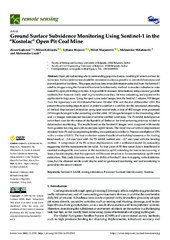Приказ основних података о документу
Ground Surface Subsidence Monitoring Using Sentinel-1 in the “Kostolac” Open Pit Coal Mine
| dc.creator | Gojković, Zoran | |
| dc.creator | Kilibarda, Milan | |
| dc.creator | Brajović, Ljiljana | |
| dc.creator | Marjanović, Miloš | |
| dc.creator | Milutinović, Aleksandar | |
| dc.creator | Ganić, Aleksandar | |
| dc.date.accessioned | 2024-02-05T08:14:30Z | |
| dc.date.available | 2024-02-05T08:14:30Z | |
| dc.date.issued | 2023 | |
| dc.identifier.issn | 2072-4292 | |
| dc.identifier.uri | https://grafar.grf.bg.ac.rs/handle/123456789/3458 | |
| dc.description.abstract | Open pit coal mining affects surrounding populated areas, resulting in terrain surface deformation. Surface deformation should be monitored as often as possible to control deformations and prevent potential incidents. This paper analyzes time series deformation estimated from the Sentinel-1 satellite images using the Persistent Scatterer Interferometry method to monitor subsidence rates caused by open pit mining activities. It is possible to measure deformations using classical geodetic methods, but those are rarely used in practice because they are time-consuming and expensive for application in large areas. Using the open access radar images from the Sentinel-1 mission, 513 images from the repository were downloaded between October 2016 and the end of December 2020. We present the processing steps in detail in order to establish a workflow for the automated processing of vertical displacement estimation using open source tools; a total of 402 images were processed: 215 images belonged to the ascending satellite orbit, 187 images belonged to the descending orbit, and 111 images were rejected because of adverse weather conditions. The PS InSAR technique has never been used for the mines of the Republic of Serbia or for land surveying practices related to deformation monitoring. The results based on the Sentinel-1 images were compared with results from geodetic leveling and with neotectonic uplift trends. The trend lines of vertical displacement obtained from PS and corresponding leveling are significantly similar (a Pearson correlation of 85% with a p-value of 0.015). The final evaluation reported results of vertical displacements at the leveling benchmark of −3.4 mm/year with the PS InSAR method and −2.7 mm/year with the leveling method. A comparison of the PS vertical displacements with a settlement model fits reasonably, suggesting that the measurements are valid. As four years of PS time series data is insufficient to establish undisputable conclusions on the neotectonics uplift, extending the time series (covering at least a decade) implies that this approach will become attractive in future neotectonic uplift trend estimations. This study illustrates not only the ability of Sentinel-1 data in mapping vertical deformations, but the obtained results could also be used for geohazard monitoring and land monitoring in general for the area of interest. | sr |
| dc.language.iso | en | sr |
| dc.publisher | MDPI | sr |
| dc.rights | openAccess | sr |
| dc.rights.uri | https://creativecommons.org/licenses/by-nc-nd/4.0/ | |
| dc.source | Remote Sensing | sr |
| dc.subject | Sentinel-1 InSAR | sr |
| dc.subject | mining subsidence | sr |
| dc.subject | Persistent Scatterer Interferometry | sr |
| dc.subject | Kostolac | sr |
| dc.title | Ground Surface Subsidence Monitoring Using Sentinel-1 in the “Kostolac” Open Pit Coal Mine | sr |
| dc.type | article | sr |
| dc.rights.license | BY-NC-ND | sr |
| dc.rights.holder | MDPI | sr |
| dc.citation.issue | 10 | |
| dc.citation.rank | M21~ | |
| dc.citation.spage | 2519 | |
| dc.citation.volume | 15 | |
| dc.identifier.doi | 10.3390/rs15102519 | |
| dc.identifier.fulltext | http://grafar.grf.bg.ac.rs/bitstream/id/12873/bitstream_12873.pdf | |
| dc.type.version | publishedVersion | sr |

